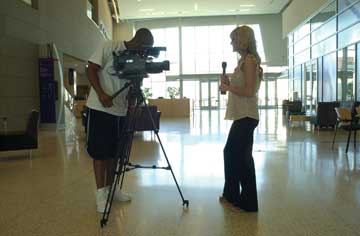Making news
It’s more than lights, camera, action for budding broadcast journalists.
Making news
It’s more than lights, camera, action for budding broadcast journalists.
Friday afternoons are crunch time in the newsroom, with reporters editing sound clips, anchors hurriedly writing scripts to read for the camera and tapes being popped in and out like candy in dispensers.
“We’ve got to get this tape to Tager (now known as the Center for Instructional Services) by 4, or we’ll have to wait until Monday before they start running it,” said John Miller ’69, director of student/TV media, hoping his statement will put the extra push on his students.
 Lose any mental images of a TV station where anchors sit in makeup before perching at a sleek desk to read from a teleprompter. This is TCU News Now, where students cram their volunteered time and bodies into a small conference room-turned-lab to record voice-overs in a closet-sized studio.
Lose any mental images of a TV station where anchors sit in makeup before perching at a sleek desk to read from a teleprompter. This is TCU News Now, where students cram their volunteered time and bodies into a small conference room-turned-lab to record voice-overs in a closet-sized studio.
In four semesters the class has won eight regional and national first-place awards, including an Emmy for best student newscast and best student feature from the National Television Academy. Most recently, Robyn Kriel ’05 was named a national winner in television in-depth reporting for her feature “Our Neighbors, Ourselves.” Kriel previously placed first in the Society of Professional Journalists’ regional competition and also won a national first place in TV features from the Hearst Journalism Awards Program.
How does Miller raise such stars? He says he just throws them into the deep end, and no one’s drowned so far.
Take senior Leslie Winchell, who dreams of being the next Katie Couric. This afternoon she sits at the Avid editing station (the same kind used by the pros), watching her taped interviews for a story on TCU’s new student apartments, the GrandMarc at Westberry Place.
She’s a little embarrassed, somewhat proud and altogether befuddled about how to put her first story together. Miller rolls up a chair beside her. He shows her how to mark the intro track and sync it with the video feed, then the sound bytes.
“It’s a different process than print reporting,” Winchell says. “If I want to tell anything, I have to have pictures. You actually have to go out, shoot, write the script and then edit. It’s a lot more time-consuming than I thought it would be.”
The students seem to know how good they have it with Miller, whose broadcast career spans 35 years, including news directorships at WFAA-TV Channel 8 and KTVT-TV Channel 11. For one thing, there’s no hierarchy in his student newsroom — everyone gets to be an anchor, video journalist, reporter and producer.
Miller notes that most students come in not knowing that 70 percent of the people working in television are behind the camera, so he requires his students to learn everything, from camera operation to copy writing for lead-ins.
“The style of news we produce is completely different now than 20 years ago,” he says. “New editing capabilities mean a faster pace and lots of sound bytes. Today’s television viewer wants something fast. The pace is so much different, so that’s how I teach.
“In news reporting, we’re just observers at an event with a camera. We bring other people into the excitement of what that event was. I’m teaching them how to go around things (at an event) they can’t control like lighting, sound and doing it all with one camera.”
Each 30-minute news program includes about 12 stories, and a new show is created every week during the semester, usually released on Monday.

Your comments are welcome
Comments
Related Reading:
Campus News: Alma Matters
From Application to Admission
Amid an increasingly selective admission process, Heath Einstein leads the team that builds the TCU community of the future.
Campus News: Alma Matters
From the Chancellor
Chancellor Victor J. Boschini, Jr., identifies what made TCU and its sesquicentennial so memorable.